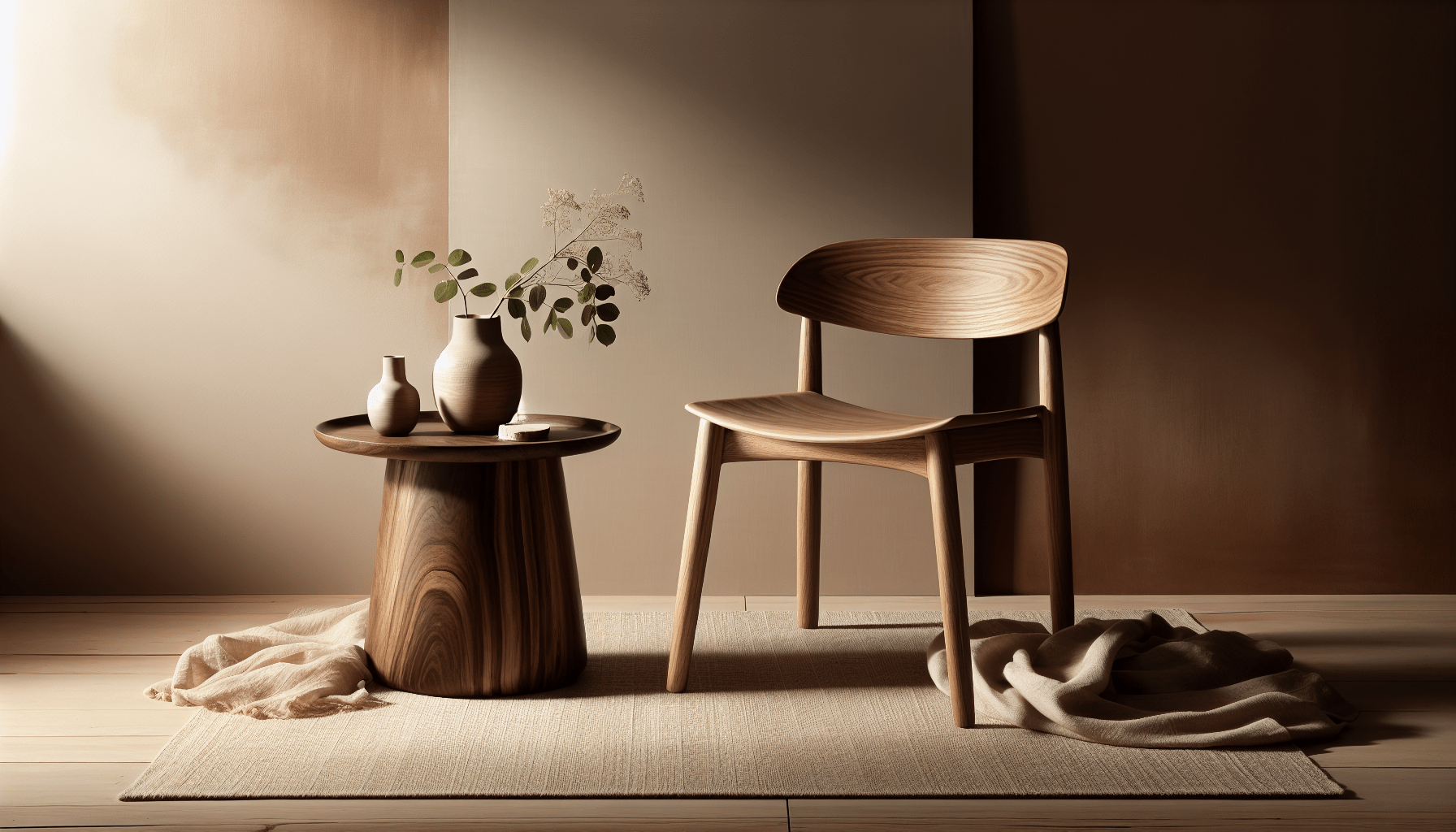How do you combine light and dark wood tones in your Japandi interiors without it feeling chaotic? It can seem like a challenge at first, especially when you’re trying to maintain that zen-like balance of simplicity and functionality that embodies the Japandi aesthetic. But with the right guidance, you’ll discover that mixing these tones can actually enhance the beauty of your space, creating warmth and serenity.
Understanding Japandi Style
Japandi is a harmonious blend of Japanese and Scandinavian design principles. It combines the minimalism of Scandinavian design with the warmth of Japanese aesthetics, focusing on form, function, and the use of natural materials. To make your interior feel calm and cohesive, it’s crucial to understand these foundational elements.
Key Characteristics of Japandi Interiors
- Minimalism: Focus on functional furniture with clean lines. Keep decor to a minimum to avoid visual clutter.
- Neutral Color Palette: Earthy tones combined with soft shades create a serene atmosphere. Think whites, beiges, and natural wood tones.
- Natural Materials: Incorporating wood, stone, and textiles brings warmth and texture into your space.
- Textured Layers: Adding different materials and patterns can provide depth without overwhelming the senses.
By familiarizing yourself with these characteristics, you’re better equipped to balance light and dark wood tones in your home.
The Role of Wood in Japandi Design
Wood is a symbolic and practical element in Japandi design. It connects the indoors with nature, enhancing the warmth of your interior. When mixing light and dark woods, you want to consider not only the color but also the grain, texture, and finish of each piece.
Light vs. Dark Wood Tones
- Light Wood: Woods like oak, maple, and birch often evoke a sense of airiness and freshness. They reflect light better, making spaces feel larger and brighter.
- Dark Wood: Woods such as walnut, mahogany, or ebony provide depth and contrast. They contribute a rich, cozy feeling, creating a striking backdrop for lighter elements.
Understanding how these tones communicate with each other is essential for achieving a harmonious look in your space.
Mixing Light and Dark Wood Tones
Successfully mixing light and dark wood tones requires a bit of thought and a clear vision. You don’t want your space to feel disjointed; instead, it should flow effortlessly. Here are some tips to guide you through the process.
1. Determine Your Dominant Wood Tone
Start by identifying whether you want your space to lean more towards light or dark wood. This will serve as the foundation for your design. If the area is already furnished with a dominant tone, use that as your starting point.
Example: If your floor is a dark walnut, consider balancing it with lighter furniture pieces to create contrast.
2. Consider Wood Types and Finishing
Not all wood tones are created equal. The type of wood you choose influences the overall aesthetic of your space significantly.
| Wood Type | Characteristics |
|---|---|
| Light Oak | Soft, open grain, reflects light well |
| Maple | Very light, has a smooth finish |
| Dark Walnut | Rich brown, deep grain, adds warmth |
| Mahogany | Dark reddish-brown, gives a luxe feel |
Pay attention to the finish as well. A matte finish versus a glossy finish can affect how light reflects off the surface and alters the perception of the color.
3. Use Contrast Wisely
Contrast is vital in achieving balance. Too much dark wood can feel heavy, while an overabundance of light shades might come across as stark. Aim for a mix that feels intentional.
Example: Pair light wooden shelves with dark wooden furniture, or bring in light wood accents on a dark wooden table setting.
4. Create Visual Balance
To create visual balance, you might want to apply the rule of thirds. Imagine your room divided into three horizontal or vertical sections, and distribute light and dark wood tones appropriately across these sections.
Visual Balance Table
| Area | Recommended Wood Tone |
|---|---|
| Floor | Dark wood for grounding |
| Furniture | Mix of light and dark (one or the other predominant) |
| Accents/Decor | Lighter wood pieces to uplift and lighten the space |
Furnishing Your Space
Once you understand the basics of mixing wood tones, it’s time to put your knowledge into action by carefully selecting furniture pieces.
1. Choose Your Focal Pieces
Begin with your focal pieces, such as the dining table or bed frame. These items often set the tone for the rest of the room. If you choose a dark wooden dining table, consider pairing it with light wood chairs for contrast.
2. Layer Textures
Mixing wood tones doesn’t just mean blending colors; it’s about texture as well. A combination of sleek, smooth finishes with raw or textured surfaces can add richness to your space.
3. Accessorize with Wood Accents
Instantly elevate your design with wooden accents. Think of vases, picture frames, or sculptures made of light or dark wood. These details can highlight your selected tones and add a personal touch.
Room-by-Room Breakdown
Let’s break down how to effectively mix light and dark wood tones in different areas of your home.
Living Room
Your living room is likely the heart of your home, making it the perfect space to showcase your wood tone mixture.
Tips for Your Living Room
- Sofa and Coffee Table: If your sofa is made of light fabric, consider dark wood for the coffee table for grounding.
- Shelving Units: Use a mix of light and dark wood for shelves, displaying lighter items against darker backgrounds to enhance visual interest.
- Accent Pieces: Add in smaller elements like wooden side tables or decorative trays, mixing both tones to tie your space together.
Dining Area
The dining area can effortlessly showcase a mix of woods, especially in the table and seating arrangement.
Tips for Your Dining Area
- Dining Table: A dark wood table can act as the centerpiece. Pair with mix-and-match chairs in light wood to create intrigue.
- Lighting Fixtures: Consider pendant lights in a light wood finish to complement darker furnishings.
- Artwork Frames: Frame artwork or mirrors in both wood tones to tie the elements of your space together.
Bedroom
Creating a tranquil atmosphere in your bedroom is crucial, and mixing wood can enhance that experience.
Tips for Your Bedroom
- Bed Frame: Choose a simple light wood bed frame and dress it with darker wood nightstands for contrast.
- Dressers and Chests: Opt for mixed wood finishes to create interest while maintaining a cohesive look.
- Textiles: Incorporate bedding or throw pillows in natural fibers to bridge your wood choices with textile textures.
Home Office
With more people working from home, your office should be a space that inspires productivity and focus.
Tips for Your Home Office
- Desk: A sleek dark wood desk can provide a strong foundation while lighter elements like shelves keep the space airy.
- Chair Choices: Ensure your seating complements both the desk and any additional wood elements in the room.
- Personal Touches: Display books or decor in contrasting wood tones for added personality.
Lighting Matters
Don’t forget about the role of lighting when mixing wood tones! Natural light helps highlight the beauty of wood grains and tones. Consider the lighting in your space and how it interacts with both light and dark woods.
Natural vs. Artificial Lighting
- Natural Light: Emphasizes the beauty of wood. When choosing pieces, consider how the light changes throughout the day.
- Artificial Light: Use lamps or overhead lights with warm bulbs to create a cozy atmosphere that softens contrasts.
Maintaining Cohesion
It’s essential to ensure that your space feels intentional and cohesive. Here are some final tips to keep your mood elevated:
- Limit Your Palette: Stick to two or three wood tones to prevent a clash of styles.
- Keep It Simple: Avoid overwhelming your space with too many different patterns or colors that distract from your wood choices.
- Think Functionality: Choose furniture not only based on aesthetics but also functionality to maintain the Japandi ethos.
Conclusion
Mixing light and dark wood tones in your Japandi interiors is a rewarding endeavor that can enhance your living space, infusing it with warmth and character. Remember, the essence of Japandi design is grounded in simplicity and balance. By thoughtfully choosing your wood finishes and arranging your space, you can create an interior that is both beautiful and calming.
As you embark on this journey of mixing wood tones, keep these principles in mind, and allow your creative instincts to shape a warm, inviting, and harmonious environment that reflects your style.

